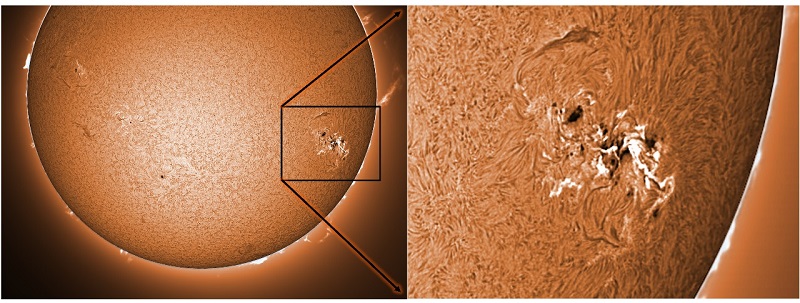The spectacular aurora also known as the Southern Lights, caused by a solar storm that impacted the Earth on 10 and 11 May, was seen and captured across the southern hemisphere, including in southern Africa in places such as Gansbaai and in Namibia.
A team of researchers from the North-West University (NWU) captured this rare and historic event through the university’s solar telescope observatory on the Potchefstroom Campus.
This observatory daily records solar activity, and on the NWU's Open Day on 4 May, two researchers and a student from the Centre for Space Research at the NWU noticed a particularly active region when they did their observations.
Dr Ruhann Steyn and master’s degree student Calmay Lee decided to focus the telescopes on where the activity was as part of a demonstration to prospective students and their parents.
At that stage they were unaware that they were recording one of the largest active regions in recent history. During the next week, the team focused their attention on the active region (AR 3664, shown in the image) while it produced several large solar flares that caused the aurora.
Calmay recorded a large solar flare produced by AR 3664 in real time at 09:00 on 11 May – an extraordinary event to capture on the NWU solar telescope.
“Although AR 3664 has now moved out of sight, it is still producing large solar flares,” says Dr Steyn.
He says while a repeat of the auroras seen in South Africa is not expected, the team will continue observing active regions in the hope of learning more about the Sun, and the as yet little understood processes that generate such beautiful phenomena here on Earth.
Largest solar storm in more than two decades
During the evening of 10 May and the early morning of 11 May, people in many parts of the world were treated to a sight rarely seen outside the polar regions.
The aurora is a result of a solar flare transporting solar energetic particles from the Sun to the Earth along the Sun’s magnetic field. Some of the particles interact with the Earth’smagnetic field and are then carried to the South and North Pole.
“The particles collide with oxygen and nitrogen atoms in the Earth’s atmosphere, emitting light with a particular colour, depending on whether it collided with either an oxygen or a nitrogen atom,” explains Dr Steyn.
He says the majority of aurora sightings in South Africa were red, which means that these collisions were mostly with oxygen atoms at an altitude between 240 and 450 km above the surface of the Earth.
On 10 May, AR 3664 spanned over 200 000 km across the solar disk. “To give an idea of the magnitude of this region: it is the equivalent of more than 15 times the diameter of the Earth.”
Prof Eugene Engelbrecht from the from the NWU’s Centre for Space Research says the presence of solar flares is not unusual, as solar activity has increased over the past five years, with the Sun approaching the peak of its usual 11-year solar cycle.
“What was different this time was the magnitude of this particular flare, along with the sheer size of the active region it came from,” he concludes.
To listen to Dr Steyn explain this rare and historic event click here

The left image shows a partial solar disk with AR 3664 (located inside the box). White prominences are visible around the edge of the Sun. The right image zooms in on AR 3664. On the image, various phenomena can easily be seen with the NWU solar telescope. Some of these are the sunspots, which are regions occurring where the Sun’s magnetic field is very strong – they appear to be darker due to cooler temperatures. You can also see the complex structures around each sunspot.
